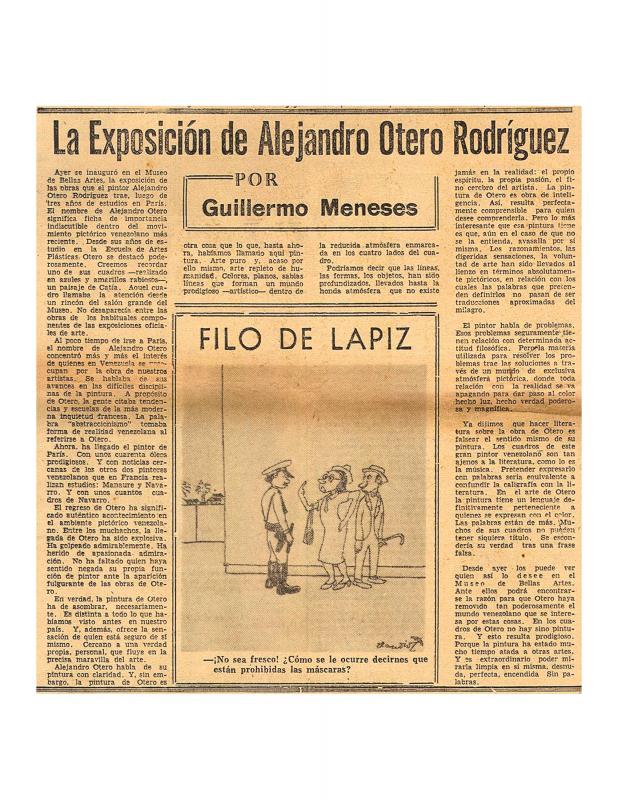This essay by Héctor Mujica is signed and dated in Paris (March 1949). Otero was awarded a scholarship [for study] in the city beginning in 1945. In mid-January of 1949, he returned to Caracas by way of Washington, where he had shown his Las Cafeteras [The Coffee Pots] series at the Museo de Bellas Artes de Caracas (a series which he created between 1946 and 1947). Mujica also comments on his series Los cráneos [The Skulls] (1946). It is likely that in this text he is actually criticizing the evolution of Otero’s work rather than his affiliation with the Parisian abstract movement. In reality, with his first “cafeteras,” the painter still offered some information that connected his paintings to aspects of the objective world; the influence of Picasso and the gestural trends then [in existence] underlie these works. It is only in his final “cafeteras” (around 1948) that he strips himself of all representation, so that the expressive power of line and structure may prevail. Within postwar Paris, abstraction was an extensive style with an aesthetic that was clearly removed from all representational models. In this sense, Otero still makes a last [attempt at] representation within his Los cráneos series.
Mujica is concerned that Parisian cosmopolitanism may affect the aesthetic trajectory of the Venezuelans who went to study in the city of lights. His affinity for social realism (practiced in Venezuela) as well as the aesthetic of socialist realism (practiced in the Eastern European nations), as well as his own standing as a Communist, place him among the supporters of an art for the masses that was concerned with the problems of man. This was the genesis of his comments on progressive art in the face of reactionary art (abstraction), which was based on [the latter’s] evasion of material reality. The show sparked controversy within the Venezuelan art [scene] regarding the validity of abstract art; with numerous critics, artists, intellectuals, and politician participating: Guillermo Meneses, Pedro León Castro, Domingo Maza Zavala, César Rengifo, among others. Positions were radicalized in the wake of the controversy, leading the Venezuelans in Paris to found Los Disidentes [The Dissidents] group (1950), the first Venezuelan abstract art group.
For other critical texts on the work of Otero, see the ICAA digital archive: the text by
J. R. Guillent Pérez, another [member] of Los Disidentes, “Realidad e irrealidad: El postigo de Alejandro Otero” [Reality and Unreality: Alejandro Otero’s Shutter] (doc. no. 1172158); the essay by Guillermo Meneses, “La exposición de Alejandro Otero Rodríguez” [The Exhibition of Alejandro Otero Rodríguez] (doc. no. 1097092); by Roberto Guevara, “La vertical vibrante de Maracay, 1968” [The Vibrating Vertical of Maracay, 1968] (doc. no. 1168201); “Alejandro Otero y la crisis en la pintura moderna” [Alejandro Otero and the Crisis in Modern Painting] by Francois Sego, included in the catalogue for the Alejandro Otero exhibition (1949) (doc. no. 850732); and by Elizabeth Schon, “Los coloritmos de Alejandro Otero” [The Color-Rhythms of Alejandro Otero] (doc. no. 1172142)].





